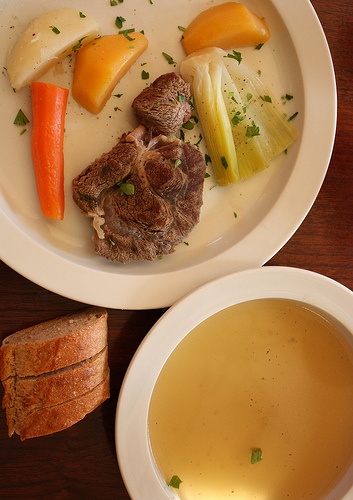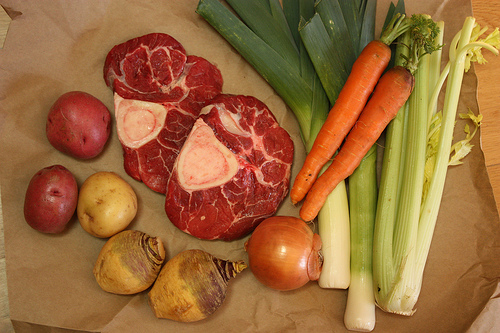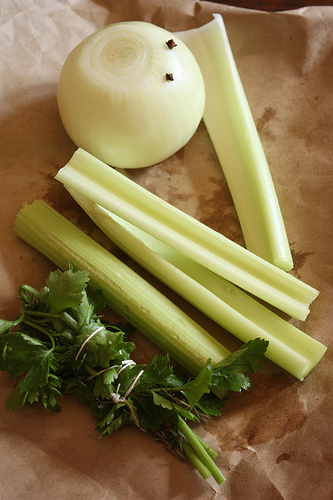
Last week I made a dish from my childhood: Pot au feu. I grew up eating the French boiled beef dinner with my parents on wintry days. (Yes, we had cold days in Southern California!) It was effortless for my mother to simmer the beef and vegetables in the afternoon and then present it for supper, the beef and vegetables on a platter and the golden broth in separate bowls. We’d eat the meal with salt and pepper, making individual piles of it to dip the vegetables and beef in. The pot au feu was always warming and satisfying.
The Vietnamese approach to pot au feu tends to be rather simple. In my 1975 copy of From Julia Child’s Kitchen, the pot au feu recipe called for roasting the beef bones and aromatic vegetables to generate a good color to the broth. In the 1940s Vietnamese classic cookbook, Lam Bep Gioi, Mrs. Van Dai suggested charring the onion (like for pho noodle soup) and adding caramel sauce (nuoc mau) to the pot au feu to create a rich color; she translated pot au feu as sup thit bo, which literally means beef soup. Vietnamese cooks didn’t have large ovens to brown their beef and vegetables so they made due. Like the original French version, Mrs. Van Dai's pot au feu had plenty of vegetables to go along with the beef. (And if you're wondering, the connection between French pot au feu and Vietnamese pho is tenuous at best.)
In the States, even though my mother had a regular stove, she just added an onion to the pot without charring it. And, she simmered beef shank that she got at the regular supermarket. That cut has a nice marrow bone and flavorful meat. It’s also relatively inexpensive and fit her budget. In other words, using shank is a terrific cheat!

To generate a lovely golden broth, I brown the beef shank at the beginning, which also adds extra good flavor. Carrots contribute to the broth color too.
I add rutabagas instead of turnips as the former has a striking color, sweet flavor, and cooks up without turning to mush. Speaking of avoiding mushy vegetables, though I have two types of potatoes in the photo above, I ended up using only the red ones because they are boiling potatoes. They keep their shape better during cooking than Yukon golds or russets.
Instead of making pot au feu for dinner like my mom used to, I made it for lunch. I got it started mid-morning and it was ready by noon. There were enough leftovers for 2 more lunches. That’s real effortless cooking.
RECIPE
Pot au Feu
Sup Thit Bo
For a slightly fancier meal, serve the pot au feu with a green salad.
Serves 6
2 large (1-inch) slices bone-in beef shank, about 2 ¼ pounds total
Salt
Black pepper
1 tablespoon canola oil
About 14 cups water
2 whole cloves
1 large yellow onion
2 large celery ribs, halved crosswise
1 large clove garlic
3 to 5 sprigs Italian parsley and 1 tablespoon of chopped parsley leaves
4 or 5 sprigs fresh thyme
1 large or 2 small bay leaves
3 large carrots, halved crosswise
2 large leeks, white and pale green parts only, halved crosswise
3 medium red potatoes, quartered lengthwise
2 medium rutabagas, quartered lengthwise
French bread
Butter
1. Pat the beef dry with paper towel and then season it with salt and pepper. In a large pot, heat the oil over high heat. Sear the beef for about 2 minutes per side, until browned. If your pot can’t fit both pieces at the same time, do the searing one piece at a time, adding both back to the pot after you’re done.
2. Add the water and bring to a boil. Skim and discard the scum that rises to the top. If there is a lot of scum that has to get removed, add back ½ cup of water. Add 1 teaspoon of salt. Stick the two cloves into the onion and add it to the pot, along with the celery. Tie the parsley, bay leaf, and thyme into a little bundle (a bouquet garni) and drop it into the pot.

3. Partially cover and adjust the heat to gently simmer the broth for a good hour, until the meat feels chewy-tender. Poke it with a fork or tip of a knife to test.
4. Add the carrots, leeks, potatoes, and rutabagas. Adjust the heat to simmer the pot, uncovered, for about 30 minutes, until the vegetables are just tender. You may want to test and pull out the vegetables at different times if they are not roughly the same in size.
5. When done, use tongs and a skimmer to transfer the beef and vegetables to a platter. (The beef should be just tender but not falling apart when the vegetables are done. If it isn’t, remove the vegetables to the platter, cover and keep on simmering the beef and broth.)
Invert a bowl over the platter to keep things warm. Retrieve and discard the onion and celery. Position a cloth or paper-towel line strainer over a clean pot and pour in the broth to strain.
6. If there is a lot of fat, skim it off. Regardless, reheat the broth before serving it. While the broth reheats, warm the bread and set out salt and pepper at the table.
Taste the broth and add extra salt, as needed. Ladle the broth into individual soup bowls or a tureen. Invite guests to have the beef and vegetables on the side, or to add them to the broth, if they’d like. A sprinkling of parsley is nice on the broth and/or the beef and vegetables.

















Danielle says
My mom made me this same soup just a couple of weeks ago when I got sick with a bad cold. Over the years it pretty much evolved into a stew, with the veggies and the same cut of beef all thrown into the broth and served in one bowl. It's so hearty and so delicious! 🙂
Laura says
I didn't realize that pot au feu made its way into the Vietnamese repertoire. With temperatures below zero in the Northeast, I might have to make this for dinner tonight. Thanks for the recipe!
Belinda @zomppa says
So colorful and flavorful! I can imagine noodles....
Viet Mom of 3 says
I make this soup with Ox tails and I cut the veggies into large chunks eating everything even celery and onions. I eat it in the broth like a soup. To prevent overbooking veggies I add them later after simmering oxtails and flavoring broth. Yum!
Simon Bao says
Andrea, which veggies and herbs did Mrs. Van Dai call for in her own recipe in her cookbook, Lam Bep Gioi? I'm curious about the leek and rutabaga, the parsley and the thyme.
Given a choice between rutabaga and turnip, I'll always take the 'baga.
Xuanie says
My mother makes something like this but she uses pork/beef bones, cabbage/brussel sprouts, beets, carrots, and, sometimes, xu xu. She serves the whole thing together with rice on the side.
Andrea Nguyen says
Simon, Mrs. Van Dai called for only "la thom" which likely meant bay leaf. They wouldn't have had much access to parsley or thyme in 1940s Vietnam.
So nice to hear how you all have had this soup with your families.
Viet Mom of 3: The gelatinous quality of oxtails is like that of the shank, only the tail would add even a softer mouth feel to the broth!
Shuku says
Andrea, this looks -LOVELY-. I've been immensely busy with life, but I had to stop in today to see what you've been up to, and ooooh, I have to make this one day. HAVE to. I just made up a big crockpot batch of bo kho for my birthday last week and it vanished in a hurry, so I'm sure this will too if I give it to the hungry hoardes at my house.
Oh, and happy Chinese New Year coming up!
Sodium lauryl sulfate says
Thank you for this great post. I'm always blown away by the courage and determination of parents to give their kids a better life, especially if it means completely uprooting and starting over in a new home.